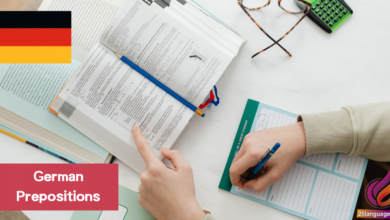Word Formation in German Prefixes & Suffixes

Unlocking the world of German vocabulary can be an exciting adventure! By mastering prefixes and suffixes, you’ll discover how new words are formed, expanding your linguistic toolbox in a snap. These building blocks not only enhance your understanding but also empower you to express complex ideas with ease. Join us as we dive into the captivating realm of word formation, where every twist and turn of a prefix or suffix reveals a new meaning waiting to be explored!
Exploring Word Formation in German Through Prefixes and Suffixes
In the German language, prefixes and suffixes play a crucial role in word formation, enabling the construction of new meanings and nuances. A prefix is added to the beginning of a word, while a suffix is placed at its end. Common prefixes include be-, ver-, and ent-, which can dramatically alter the meaning of a verb. As an example:
- fahren (to drive) becomes verfahren (to lose one’s way).
- stehen (to stand) changes to bestehen (to consist of).
- kommen (to come) turns into entkommen (to escape).
Suffixes, on the other hand, often denote grammatical categories such as noun formation or verb conjugation. Familiar suffixes include -ung, -keit, and -heit. Examples of this include:
- die Bildung (the education) from bilden (to educate).
- die Fähigkeit (the ability) from fähig (able).
- die Freiheit (the freedom) from frei (free).
| German Word | Type | Translation |
|---|---|---|
| verstehen | Prefix | to understand |
| aufgabe | Suffix | task (from auf + geben) |
| misslingen | Prefix | to fail |
| Gesundheit | Suffix | health |
Unlocking Complexity: Understanding German Word Formation Techniques
German word formation techniques often rely on two primary methods: compounding and derivation. Compounding involves combining two or more words to create a new word, frequently producing longer nouns. As a notable example, the German word Handschuh translates to “glove,” literally meaning “hand shoe.” Another example is Zahnarzt, which means “dentist,” derived from Zahn (tooth) and Arzt (doctor). This method allows for the concise expression of complex ideas and concepts by merging relevant nouns. Here are some key points concerning compounding:
- The first part typically specifies a characteristic of the second.
- Often used in technical and everyday language.
- Compounds retain their typical gender and plural forms.
Derivation, on the other hand, modifies a base word by adding prefixes or suffixes, changing its meaning and grammatical role. For example, the verb laufen (to run) can transform into the noun Läufer (runner) by adding the suffix -er. Similarly, prefixing the verb spielen (to play) with ver- generates verspielen (to lose something by playing). Understanding these derivation processes equips learners with the tools to expand vocabulary effectively. Here are key elements of derivation:
- Prefixes may indicate negation, repetition, or change in direction.
- Suffixed modifications can denote agents, instruments, or abstract concepts.
- Different prefixes and suffixes can alter the grammatical class of the word.
| German Example | Rule/Technique | English Translation |
|---|---|---|
| Handschuh | Compounding (Hand + Schuh) | Glove |
| Zahnarzt | Compounding (Zahn + arzt) | Dentist |
| Läufer | Derivation (laufen + -er) | Runner |
| verspielen | Derivation (spielen + ver-) | To lose by playing |
Building Vocabulary: Practical Strategies for German Prefixes and Suffixes
Understanding prefixes and suffixes is crucial in expanding your German vocabulary. German has a rich system of word formation that utilizes a variety of prefixes and suffixes to change the meanings of base words.Prefixed verbs often indicate direction, negation, or intensity. For example:
- kommen (to come) can become vorkommen (to occur) when prefixed with vor-.
- stellen (to set) becomes herstellen (to manufacture) with the prefix her-.
Suffixes can also significantly alter the meanings of words, often changing verbs into nouns or adjectives into adverbs. Common suffixes include -ung for nouns and -lich for adjectives. As an example:
- lernen (to learn) changes to lernung (learning).
- freund (friend) becomes freundlich (amiable) with the addition of -lich.
| German Word | Rule | English Translation |
|---|---|---|
| machen | Prefix ver- indicates a change in state | to make |
| verarbeiten | Derived from arbeiten (to work) | to process |
| schön | Suffix -heit forms a noun | beautiful |
| schönheit | Change to noun form | beauty |
Mastering the Art of Word Formation in German for Effective Communication
In German, compound nouns are a notable aspect of word formation that can greatly enhance your vocabulary and improve your communication skills.Unlike in English, where words are often separated, German combines multiple nouns into one long compound word. This feature allows for more precise expressions. Some key points to remember include:
- German compound nouns are typically formed by joining two or more nouns.
- The last noun in the compound usually indicates the core meaning of the entire word.
- Both nouns retain their gender, and the gender of the compound noun is usually steadfast by the last noun.
For example:
- Die Flaschenpost (the bottle mail) combines “Flasche” (bottle) and “Post” (mail).
- Der Staubsauger (the vacuum cleaner) combines “Staub” (dust) and “Sauger” (sucker).
Understanding the rules of prefixes and suffixes will further aid in word formation. German uses a variety of prefixes that can alter the meaning of a base word, and also suffixes that modify the word’s function.Here are some examples:
| German Example | Prefix/Suffix Rule | English translation |
|---|---|---|
| um- (partition) | Prefix indicating change or conversion | umbauen – to rebuild |
| -ung | Suffix indicating a noun derived from a verb | Bildung – education (from “bilden” - to form) |
The Conclusion
Wir haben heute die faszinierende Welt der Wortbildung im Deutschen erkundet, insbesondere die Verwendung von Präfixen und Suffixen.Ihr habt gelernt,dass Präfixe oft die Bedeutung eines Wortes verändern können,während Suffixe die Form oder Funktion eines Wortes beeinflussen. Durch die Anwendung dieser sprachlichen Werkzeuge könnt ihr nicht nur euren Wortschatz erweitern, sondern auch die Nuancen der deutschen Sprache besser verstehen.
Denkt daran, dass Übung der Schlüssel zum Erfolg ist! Nutzt die neuen Präfixe und Suffixe, die ihr gelernt habt, in euren eigenen Sätzen. Lest deutsche Texte, hört deutschsprachige Musik oder schaut Filme, um die Struktur und den Gebrauch dieser Wortbildungsstrategien in einem natürlichen Kontext zu sehen.
Jede neue Sprache ist wie ein Puzzle – je mehr Teile ihr hinzufügt, desto klarer wird das Bild. Ihr seid auf einem großartigen Weg, euer Deutsch zu verbessern. Glaubt an euch selbst und habt Freude daran, die Sprache weiter zu entdecken! Bis zum nächsten Mal!





























